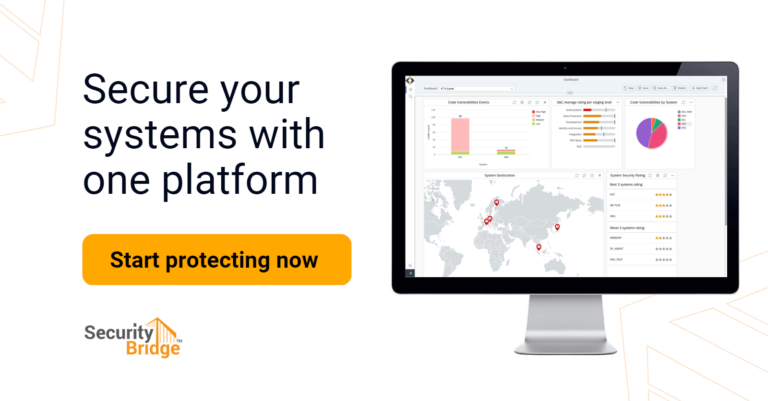
SAP RFC: The Power of Process Integration is Nothing Without Security

Chapters
Share Article
Seamless integration and efficient communication between software systems is crucial to optimize organizations’ operations and efficiency, especially in today’s rapidly evolving digital landscape. SAP Remote Function Call (RFC) is an SAP vital component that permits secure and trustworthy communication between SAP systems and external applications. Explore in this article how SAP RFC can help you streamline integration and data exchange and how you can secure RFC communications to ensure business continuity.
Why is SAP RFC important for businesses?
RFC is so crucial for businesses because it’s the communication interface used within SAP systems: it enables the exchange of information between them. When invoking RFC, a function is requested to be executed within a distant system. SAP RFC offers numerous benefits to companies, including:
- Seamless Integration: SAP RFC empowers organizations to integrate SAP systems with other enterprise applications, such as customer relationship management (CRM), supply chain management (SCM), and human resources (HR) systems, ensuring data consistency and accuracy across systems.
- Automation and Enhanced Efficiency: By leveraging SAP RFC, businesses can automate complex operations and that span across different systems. RFC-enabled functions allow for the execution of complex operations and data transformations, reducing manual effort and improving process efficiency.
- Real-Time Data Reporting and Exchange: SAP RFC enables external applications to obtain real-time data from SAP systems, providing instantaneous access to critical business information. This capability is particularly valuable for generating reports, conducting analytics, and enabling informed decision-making.
- Smooth Intersystem Communication: SAP RFC enables seamless communication between SAP systems, allowing data exchange and business process integration. This functionality is essential for organizations with multiple SAP instances or decentralized systems, ensuring smooth collaboration and data consistency.
Types of SAP RFC to streamline operations:
Understanding the different types of SAP RFC is crucial for businesses to optimize their operations and achieve desired outcomes:
- Synchronous RFC: Enables real-time interaction where the caller application waits for a response from the SAP system before proceeding. This type is ideal for immediate data retrieval or transactional operations.
- Asynchronous RFC: Allows the calling application to continue processing without waiting for an immediate response from the SAP system. Both systems do not need to be available simultaneously during execution, and there is no immediate requirement to send the result back to the calling system. Asynchronous RFC enhances performance by enabling parallel execution of tasks.
- Transactional RFC: Transactional RFC is an asynchronous communication method that ensures the called function module is executed only once in the RFC server, even if the data is sent multiple times due to network issues. It executes multiple function calls as a single logical unit, ensuring consistency and data integrity across the SAP system.
Ensuring security in SAP RFC implementation:
To protect against unauthorized access and data breaches, organizations must prioritize security. When implementing SAP RFC, they should consider the following essential measures:
- Secure Configuration: Implement secure configuration practices to safeguard SAP RFC implementation, making sure that only authorized users and systems can access and exchange data.
- User Authentication and Authorization: Enforce strong user authentication methods and robust authorization controls to prevent unauthorized access to SAP systems via RFC.
- Encryption and Secure Network Protocols: Leverage encryption techniques and secure network protocols, such as SSL/TLS, to secure data transmitted through SAP RFC.
- SAP Interface Monitoring: Implement tools capable of visualizing the complexity of SAP interfaces and identifying malicious activities in the mass of data transfers where attacks are often hidden.
Conclusion:
SAP RFC stands out as a powerful solution for organizations relying on SAP systems, enabling efficient integration and communication between systems that are crucial for business success. By streamlining integration, automating processes, and enabling real-time data exchange, SAP RFC empowers businesses to optimize their operations and stay ahead in an increasingly competitive landscape. Prioritizing security considerations ensures the confidentiality, integrity, and availability of data transferred via SAP RFC. By embracing this, businesses can harness the true potential of their SAP ecosystem and unlock new levels of efficiency and growth.

